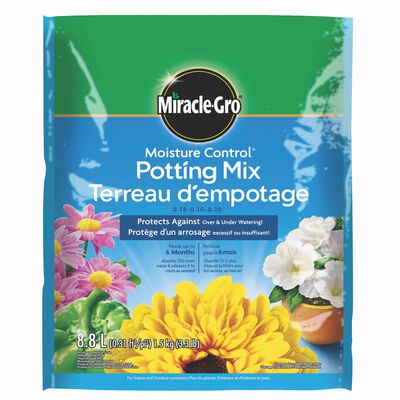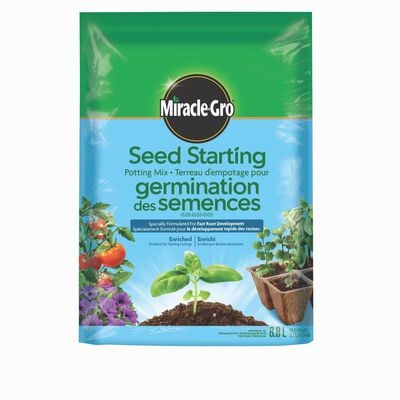
Growing Cucumbers
- Grow cucumbers in a spot that gets 6-8 hours of sunshine daily and has good air circulation.
- Plant once all chances of frost have passed.
- Give vines a vertical growing path by planting next to a trellis or fence.
- Improve soil nutrition and drainage by adding Miracle-Gro® Garden Soil All Purpose (in-ground), Miracle-Gro® Moisture Control® Potting Mix (containers).
- Enjoy ripe cucumbers sooner with starter plants.
- Check soil moisture often and water when the top inch becomes dry.
- Add a 3-inch layer of mulch to help prevent weeds and retain soil moisture.
- One month after planting, start feeding with Miracle-Gro® Shake 'N Feed® Tomato, Fruits & Vegetables Plant Food
- Harvest cucumbers when they're big enough to eat.
Include cucumbers on your must-grow list because they're easy to care for, prolific, and taste delicious. Planting cucumbers begins with either seeds or young plants, and you can grow them in a traditional vegetable garden, raised bed, or container. Choose long green varieties or smaller versions ideal for canning. "Burpless" cucumbers help reduce the gassiness some diners experience, and bush types yield wonderfully in pots.
Here are our top tips for growing cucumbers.
PREP
Plant cucumbers in a spot that receives 6 to 8 hours of sun daily. Select soil that provides a well-drained, nutrient-rich base. Fill containers with Miracle-Gro® Moisture Control® Potting Mix. For in-ground planting beds, mix 3 inches of Miracle-Gro® Garden Soil All Purpose into the top 6 inches of soil. If you're planting cucumbers in raised beds, fill beds with Miracle-Gro® Garden Soil All Purpose or equal parts garden soil and potting mix.
Choose the right pot size if you'll be planting cucumbers in containers. For non-vining or bush cucumbers, use a minimum pot size of 12 inches (5 gallons). With vining cucumbers, use a pot that's at least 24 inches across.
PLANT
When planting cucumbers, wait until soil temperature has warmed and there's no chance of frost in the forecast. The fastest way to grow cucumbers is to begin with strong, vigorous plants. Already well on their way to maturity, they'll bring you that much closer to harvest time. Aim to set out young plants 1 to 2 weeks past your region's average last frost date. You can also grow cucumbers from seed started indoors, in Miracle-Gro® Seed Starting Potting Mix. You'll want to plant them about 2 to 3 weeks before the last expected frost date.
Check the seed packet or stick tag for proper spacing for cucumber plants, usually 3 to 5 feet apart. If you're training vines on a trellis instead of letting them run along the ground, they can be planted closer together (6 to 9 inches apart).
Water well after planting cucumbers.
GROW
Cucumbers need a steady water supply to keep them from becoming misshapen or bitter tasting. Check the soil regularly; when the top inch is dry, you need to water. Drip irrigation works well with cucumbers because it keeps leaves dry, which can help reduce disease outbreaks.
Mulch around (but not on top of) plants with 2 to 3 inches of Scotts® Nature Scapes® Colour Enhanced Mulch, straw, shredded leaves, pine straw, or untreated grass clippings. Mulching reduces weeds by blocking their access to the sun, helps soil retain moisture, and keeps cucumbers clean.
In addition to the initial infusion of nutrients from top-quality soil, growing cucumber vines need a steady supply of plant food throughout the growing season in order to produce the best harvest. Mix Miracle-Gro® Shake 'N Feed® Tomato, Fruits & Vegetables Plant Food. into the soil around your cucumber plants, following label instructions. This will provide extra nutrition to help cucumbers grow, and feeds for up to 6 weeks.
Growing cucumbers on trellises can actually increase your harvest by allowing more sunlight and air circulation to vines (this reduces disease). Individual cucumbers also grow straighter when they're raised on trellises.
HARVEST
Check plants daily once cucumbers starting ripening, as they taste best when young. Harvest cucumbers whenever they're big enough to use, using a knife or shears and leaving a short stem stub on the fruit to help it last longer. Cucumber vines tend to produce more when harvested regularly.
Store cucumbers in the veggie drawer in the fridge; they should last about a week. Perforated plastic bags increase humidity and help fruit last longer.
USE
Serve cucumbers raw, slicing, chopping, or grating them into salads or onto sandwiches. If you have an abundance of cucumbers, make pickles or relish.
Ready to start planting and growing your own cucumbers? Click on any of the product links above for more information, to purchase the product online, or to find a retailer near you.



